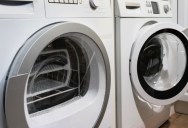Experts Say You Should Be Cleaning Your Washer And Dryer. Here’s A Guide On How To Make Sure Both Are Sparkling.
by Trisha Leigh
There are so many things related to cleaning and taking care of a home that you have no idea are happening when you’re a kid.
Then you get your own place and find yourself texting your dad (or your friends) things like “why does my washing machine say it needs to be cleaned? Doesn’t it do the cleaning?”
It does, but also, grime from your dirty clothes and detergent and hard water build up inside it, so yes – you have to clean it. If you do, it will repay the favor by working up to standard and not having to be replaced or need costly repairs.
In order to keep your washing machine in tip-top shape, you just need a few materials that you likely already have in your home: vinegar, baking soda, bleach, a microfiber cloth, a spray bottle, and a small brush.
Inside the washing machine drum you’ll find buildup from your detergent, and also possibly mold or mildew. If you’ve got pets, you’ll also likely encounter their hair and other debris in there, too. Use your spray bottle filled with vinegar first, then your microfiber cloth to wipes it all down. If you notice areas that are extra grimy, use the baking soda. If there’s a smell, that’s when your bleach will come in handy.
Make sure you check the gaskets and seals and get into all of the nooks and crannies. Moisture is more likely to get trapped there, so mold and mildew can form – use the bleach if you have to!
Once you’re sure it’s all clean, run a hot water cycle to rinse it all and prevent buildup.

Every once in a while the washer will also need a deep clean. If you’ve got a top-loading model, set it to its highest water level and temperature setting. Pour four cups of white vinegar into the drum and start a cycle. Once it’s full, pause the machine and allow the hot water and vinegar to soak for an hour.
Then, start the machine again and after it’s gone through the first rinse cycle, pause it again to add a cup of baking soda, then let it finish.
Once it’s done, you’ll want to leave the top up and let it dry out completely.
Don’t forget to take the detergent tray out, too, and clean and the empty slot well before putting it back together.

If you have a front-load washer you need to deep clean, it’s essentially the same procedure. If your machine smells a lot, you might want to use bleach instead of the vinegar.
You also don’t want to overlook your drain or your filter, which can get clogged and shorten the life of your washer.
Make sure your washing machine is off, then disconnect the drain from the pipe (or the back of the machine if it drains into a sink). Place it into an empty bucket to collect anything that drains out, then clean out any gunk lodged inside. After that, you can soak it in vinegar to remove mildew, and clean the opening at the back of the machine before you put it all back together.
Most top-load washers made after 2001 don’t have filters, but if yours does, you’ll need to check the manual in order to locate it. Once you do, remove it and spray it with vinegar before brushing it lightly and rinsing it off. You should make the quick-clean version a part of your monthly cleaning duties, and do a deep clean 2-4x a year.
Next up: your dryer.
If you don’t properly maintain your dryer you could see its efficiency go down and your electric bill go up. To stay on top of it you’ll need the same materials you used on your washer, plus a vacuum and a screwdriver.
First, remove the screen and vacuum the interior of the lint trap with the tool or attachment that can reach the furthest. Use a small brush dipped in warm, soapy water to scrub the mesh and the cavity until it’s free of buildup.

Next, turn off and unplug your dryer. If you use gas, close the shut-off valve in the gas supply line, then disconnect and. ap the line pipe before you get started.
After that you’ll pull the dryer out so you can get better access to the vent duct. Unscrew the vent clamps with your screwdriver or remove the tape that attaches the vent to the back of the dryer.
You can pull out the large pieces of lint with your hands, then use a dryer cleaning brush or a vacuum to get the rest. Reattach. Do the same to your exterior vent.
After you clean the inside with the same materials you used on your washer drum, you can put it all back together and push it back into place.

Experts say you’ll want to clean your lint trap after every load, and deep clean the lint trap every 6 months. The vent and ducts should be ok for 1-2 years after cleaning.
So, there you have it!
A couple more tasks to add to those monthly/quarterly/annual cleaning sprees – and who doesn’t love that?
If you found that story interesting, learn more about why people often wake up around 3 AM and keep doing it for life.
Categories: SCI/TECH, STORIES
Tags: · buildup, cleaning, cleaning tips, dryer, hacks, picture, science, single topic, spring cleaning, tips, top, tricks, washing machine

Sign up to get our BEST stories of the week straight to your inbox.




